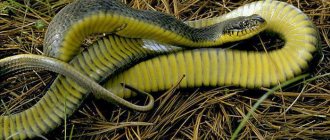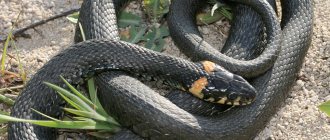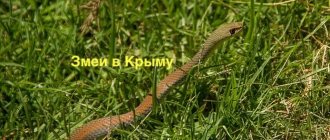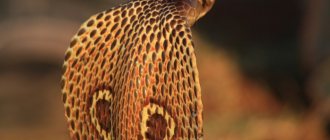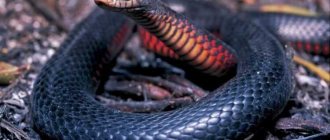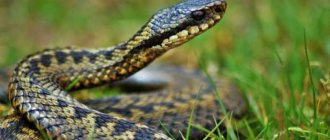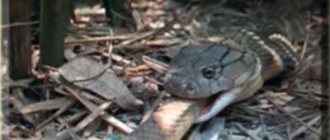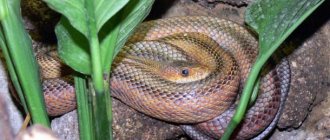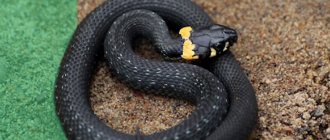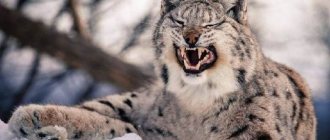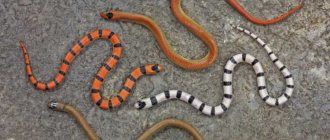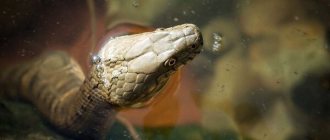The Rostov region, unlike the Leningrad region, has a rather rich snake world. In total, there are 10 species of snakes in the Rostov region. Among them, 6 are harmless to humans and 4 are poisonous, which can pose a serious danger to humans.
In spring and summer, snakes are most active. To know your enemy by sight, we have prepared this article for you. In it you will find a list of snakes living in the Rostov region, find out their names and see photos from which you can identify poisonous and non-venomous representatives of the snake world.
In today's publication we will tell you about what kind of snakes are found in the Rostov region, present their names and photos.
Poisonous snakes
Some reptiles have settled only in the steppe/forest-steppe, others are found throughout the Rostov region. Poisonous snakes are represented by 4 species, the poison of which is dangerous to both humans and livestock. The only thing you need to know is that the snake will not attack first unless you disturb it (by accidentally stepping on it or poking it with a stick).
Steppe viper
A diurnal snake that chooses open spaces - steppes and semi-deserts of the Rostov region. The most numerous populations are recorded in the southern, eastern and southeastern regions.
The steppe viper is never too long, growing on average to 61–63 cm, where 55 cm is on the stocky body, and the rest is on the short tail. Characteristic features are narrow (vertical column) pupils, wedge-shaped head and gray-sand coloring with a zigzag pattern along the ridge. Melanists (black individuals) are born extremely rarely near Rostov.
From time to time, horses and small livestock die while grazing due to the bites of the steppe viper. A fatal outcome for a person is unlikely unless anaphylactic shock occurs and help does not arrive in time.
The steppe viper, although poisonous, is shy. When encountered, it quickly retreats, but attacks under force if the path to retreat is cut off.
In most cases, viper venom causes dizziness, shortness of breath, noticeable weakness, chills, swelling, and the formation of hematomas/blisters at the site of the bite. A healthy body copes with intoxication within a few days.
In recent years, due to rapid human activity, the world population of the steppe viper has been declining: Russia, where the species is also endangered, is no exception. At the end of the last century, the extraction of venom from the steppe viper was stopped, and it itself was taken under the protection of The Bern Convention (Convention on the Conservation of Fauna/Flora and Natural Habitats in Europe).
Common viper
The regional range of the species mainly covers the northern and northwestern regions of the Rostov region, although some specimens are also found in the central regions.
Medium sized reptile. Meter-long snakes are found in the north of their world range (for example, in Scandinavia); smaller vipers (up to 65 cm) live in the Don steppes. The snake has a thick body, a short tail and a triangular head, visually separated from the neck.
Body color varies and can be gray, yellow-brown, brown and even reddish with a copper tint. Melanistic black vipers are also found here and there.
This viper also has a zigzag pattern running down its back that forms an "X" on its head, and the tip of its tail is often colored red, orange or yellow.
The venom of the common viper provokes extensive hemorrhages and the appearance of necrotic areas near the point of the bite, so the strength of the poison is determined by the proximity of the bite to the head. Typical symptoms are severe weakness, dizziness and chills. The bite of a common viper rarely leads to death: only if you are allergic to the toxin.
Nikolsky's viper
Not all herpetologists recognize it as an independent species, calling it a subspecies of the common viper. Despite the similarity with melanists, Nikolsky's viper has an independent morphology, differing from other vipers not only in its intense black color, but also in the nuances of the structure of the scales and cornea of the eye - the pupil is barely noticeable, as it is surrounded by a black iris.
Adult reptiles grow up to 85 cm in length with a fairly heavy and dense body, slightly reminiscent of a spindle.
Interesting. Young snakes are lighter than adults and colored gray-brown with a brown zigzag along the ridge: by the 3rd year of life, the scales darken and the pattern disappears.
The most formidable viper of the Rostov region lives in the north, west and north-west of the Rostov region, choosing, as a rule, the outskirts of ravine (usually broad-leaved) forests cut through by streams and rivers.
The diet of the Nikolsky viper includes:
- shrews;
- small rodents;
- frogs;
- ground-nesting birds;
- their eggs and chicks.
Young snakes hunt small lizards, brown frogs, spadefoot moths, fish and do not disdain carrion. On land, Nikolsky’s viper crawls slowly, but swims faster than other “Rostov” vipers.
The venom of the Nikolsky viper is classified as quite dangerous due to the lethal concentration of cardiotoxins in it (disturbing the functioning of the heart muscle) coupled with hemorrhagic poisons. After a bite, rapid heartbeat and convulsions are observed, and in some cases, fainting and coma. A fatal outcome is not excluded (especially for allergy sufferers).
Now Vipera nikolskii is protected on the territory of the Khopersky Nature Reserve.
Common cottonmouth
It is also Pallas's muzzle - the most common species of the genus of copperheads, preferring semi-deserts and steppes. Inhabits the local, driest and hottest regions of the Rostov region: the southeastern and Salsk steppe.
The snake is recognized by its brown or gray-brown back, dotted with dark brown transverse spots. Smaller spots are observed on the sides, as well as on the head, along the sides of which there is a dark postorbital line. Among the representatives of the species, black and brick-red individuals are not uncommon.
Interesting. Cottonmouths get their generic name from the enlarged scutes (bone growths) on their heads.
This is a pit-headed snake, capable of sensing the presence of warm-blooded animals even in pitch darkness. Invertebrate animals become the prey of growing copperheads. The diet of adult snakes consists mostly of small vertebrates:
- steppe rodents;
- shrew;
- lizards and snakes;
- small birds/chicks;
- bird eggs.
The sting of the copperhead is painful to humans, but is often fatal to horses and other domestic animals. A snake attacks a person if he poses a threat, which (in the absence of timely assistance) can result in paralysis of the respiratory system. An hour after the snake attack, hallucinations and loss of consciousness are observed, as well as hematomas, hemorrhages and swelling in the bite area, leading to tissue necrosis.
Return to content
Description of the steppe viper
The length of the reptile's body with head is on average 45-48 cm; the known record for this species is 70 cm. Females are slightly larger than males.
On top, the snake is brownish-gray in color with the same zigzag stripe along the ridge as that of an ordinary viper. Sometimes this stripe is broken into separate spots. The head has a symmetrical pattern of dark spots. Completely black individuals (melanists) are very rare among this species.
The steppe viper differs from the common viper primarily in its smaller size. In addition, the upper side of its head sharply turns into the side, forming a pronounced rib; as a result, the lateral edge of its muzzle is pointed (in the common one it is rounded) and slightly raised above its upper part.
| Common viper | Steppe viper |
Non-venomous snakes
Three species of snakes, two species of grass snakes and a copperhead are all non-venomous snakes in the Rostov region. Their trouble is that they are subjected to completely unreasonable reprisals from ignorant tourists who do not know how to distinguish between dangerous and harmless reptiles.
Patterned runner
It belongs to the family of colubrids and is adapted to life in diametrically different biotopes - steppes, meadows, river valleys, on the outskirts of swamps, in salt marshes, rice fields, dunes, juniper forests, reeds, mountains, as well as in coniferous and mixed forests.
It was this gentle and harmless snake that local residents nicknamed the “chess viper,” exterminating it so diligently that the patterned snake was included in the Red Book of the Russian Federation.
Adult snakes grow up to one and a half meters and are characterized by extremely variable color from brownish-gray to brown and black (in melanists). There are 4 contrasting stripes along the ridge, two of which extend onto the tail. Two dark spots are visible on the top of the head, and a temporal stripe extends through the eye (with a round pupil).
The patterned snake excellently climbs trees, rocks and on the ground, swims and dives excellently. It usually takes refuge in voids under roots, old hollows and rock crevices.
The patterned runner's menu includes:
- small mammals;
- birds, their chicks/eggs;
- amphibians;
- small snakes;
- fish;
- insects.
The natural enemies of the snake are considered to be terrestrial and feathered predators, in particular the steppe eagle, and more recently also humans, although the snake itself tries not to get in its path.
Four-banded climbing snake
Another colubrid that inhabits well-warmed but shaded biotopes with fairly high humidity. In the Rostov region, the four-striped snake selects ravine and ravine forests, river floodplains, overgrown sandy wastelands, rocky slopes (overgrown with bushes), orchards and vineyards. It uses crevices in rocks, hollows and holes, as well as deep cracks in the ground for shelter.
The four-striped snake is larger than the patterned snake: with an average length of 1.5 m, there are also specimens of more than 2 meters.
This is a rather slender snake with a narrow diamond-shaped head and a weakly defined neck. There are 3 known subspecies of the four-striped climbing snake (2 of them are not found in Russia), differing from each other in appearance and behavior.
Gastronomic preferences are not limited to rodents: the snake hunts young hares, birds and destroys bird nests. Adult snakes often eat lizards. The snake not only easily slides along the trunks, but also without tension throws itself from one branch to another if they are separated by 0.5–0.6 m.
Natural enemies of the snake are foxes, ferrets and birds of prey. Having noticed a person, the snake tries to hide in the thick grass, but this does not always work. It is often mistaken for a viper and killed, which is why the four-striped climbing snake ended up on the pages of the Red Book of the Russian Federation.
Caspian or yellow-bellied snake
Received the honorary title of the largest snake not only in the Rostov region, but also in Europe as a whole, since some mature individuals grow up to 2.5 meters.
Inhabitant of arid (open/semi-open) biotopes - semi-desert, steppe, rocky areas, river cliffs, forest belts, bushes, slopes of ravines and ravines. He does not shy away from cultivated landscapes - gardens and vineyards, stone fences, abandoned buildings and haystacks. Crawling out onto the road, it often dies under the wheels of cars.
The Caspian snake hunts anything that fits into its throat. Favorite game is small mammals and birds. The snake destroys mice and rats in huge quantities, periodically snacking on gophers and raccoons.
The yellow-bellied snake swallows small animals alive, but presses large ones to the ground, crushing them with the weight of its body.
The snake is not at all similar to a viper, but despite this fact it constantly suffers at the hands of panicked amateurs, which is why it is classified as a vulnerable species in Russia.
True, the latter also suffer from a huge snake, which (unlike the same viper) does not like to run away, but prefers to fiercely defend itself. Suspecting the enemy's malicious intent, the snake curls up into a ball, sharply throwing its body upward to bite in the face or neck. Of course, the snake has no poison, so all it can do is injure the skin.
Common copperhead
It is found almost everywhere in the Rostov region. Like the snake, it belongs to the family of colubrids, but is considered conditionally poisonous, since its toxins affect small animals and insects.
The copperhead is distinguished from many European snakes by a rather long dark stripe crossing the eye with a round (like all non-venomous reptiles) pupil. The teeth grow deep inside, thanks to which the victim receives a minimal dose of poison. Adult copperheads are no longer than 60–70 cm and are usually always covered with several rows of transverse spots (more clearly expressed in the neck area), often merging into uneven stripes. The back of the head is also decorated with a pair of spots/stripes.
Important. Copperheads are painted in different colors - gray, brownish-yellow, all shades of brown and even copper-red. Very dark individuals are also born, even black (with melanism).
The copperhead preys on insects, young snakes, lizards and small rodents. The once wide range of the species, already recognized as vulnerable, is rapidly narrowing, which is due to anthropogenic factors - plowing up of habitual habitats, cutting down trees and others.
Water snake
A common species for the Rostov region (especially for the Don floodplain), adhering to natural bodies of water. It is easy to distinguish it from the common grass snake by the absence of light temporal spots. This is an olive-colored snake whose back is strewn with dark spots running in a checkerboard pattern.
The color of the water snake can also be monochrome – black or olive, without spotting. An adult snake grows up to 1–1.3 m, less often up to 1.6 m. The eyes are round, slightly bulging. The water snake swims most of the day, catching fish and small animals.
Common snake
Perhaps the most common snake in the Rostov region. A snake, if it is not melanistic, is difficult to confuse with another snake: it is identified by two light markers behind the ears (white, yellow, orange or pink). Females are larger than males and can reach up to 2.5 m, with an average length of no more than a meter. Snakes feed on rodents, frogs and fish. The snake itself is hunted by some predators, including birds, as well as storks.
Return to content
Habitats
The steppe viper is common in Central Asia, Central and Eastern Europe, Northwestern China, Turkey, Iran, Kazakhstan and the Caucasus. This is a fairly common species for the south of Western Siberia and the south of the European part of Russia (in the north its habitat reaches Kazan).
Unlike the common viper, the steppe viper is found in open spaces. It is not for nothing that it received such a name: its favorite habitats are various types of steppes. It also lives on rocky mountain slopes, alpine meadows, sea coasts, riverine forests, ravines, semi-deserts and loose sands. It can also be found in pastures and fields.
In favorable habitats, its population density can be extremely high. For example, in Kazakhstan, in the tea thickets, the number of these snakes can reach up to 45 individuals per 1 hectare, and in the Ciscaucasia - up to 60! In such places you can’t even take a step without bumping into this snake. However, the steppe viper does not have such obvious “snake foci” as are known in the common viper - it is more evenly distributed.
Actions to take when encountering a snake
We must let her leave, which she will definitely take advantage of. If the attack occurred due to your carelessness (you stepped on a snake or picked it up with a stick), take any antihistamine. To avoid anaphylactic shock, inject tavegil solution (1-2 ml) under the skin, cutting into the wound from all sides. For severe symptoms, administer dexazone or dexamethasone (2-3 ml) intramuscularly, then take the victim to the hospital.
Attention. Do not suck out the poison (this is useless), do not cauterize or cut the wound, so as not to aggravate the death of tissue.
Keep the bitten limb immobile, drink 70 g of vodka/alcohol (this is a vasodilator), and drink plenty of diuretic liquid (herbal tea, beer, coffee), since the poison is excreted exclusively through the kidneys.
Return to content
Republic of Bashkortostan
Status: IV category. A rare, little-studied species on the periphery of its range.
Spreading
In the Republic of Bashkortostan it has not been studied enough. Found in the southern regions: Meleuzovsky (along the Nugush River), Baymaksky (Irendyk Ridge), Khaibullinsky (floodplain of the Sakmara River).
Number
The northern border of the species’ range runs through Bashkortostan, where isolated encounters have been recorded. There are no data on current numbers.
Source: Red Book of the Republic of Bashkortostan. Volume 2. Animals. Ed. V.N. Alekseev, V.A. Hasek, P.Yu. Gorbunov, N.E. Kolcheva, M.N. Kosarev, V.N. Olshvang, P.V. Ore prospector, N.M. Samoilova, A.I. Smagin, V.P. Snitko, V.V. Tarasov, O.A. Torgashov, A.S. Chichkova, B.M. Chichkov (2014) Ufa: Informreklama
Lifestyle
Life expectancy can reach 15, and according to some sources, 30 years. However, observations in Sweden indicate that snakes rarely survive beyond two or three years of breeding, which, taking into account the achievement of sexual maturity, gives an age limit of 5-7 years. The viper quickly adapts to any terrain; in the Swiss Alps it rises to 2600 m above sea level. Habitats are more diverse in the northern and eastern parts of the range, where the snake often colonizes peat bogs, heathlands, cleared mixed forests, the banks of various freshwater bodies of water, wet meadows, field edges, shelterbelts, and dunes. In southern Europe, biotopes are mainly limited to wet depressions in mountainous areas. Distribution is uneven depending on the availability of places suitable for wintering. The saddle, as a rule, does not move further than 60-100 meters. The exception is forced migration to a wintering place; in this case, snakes can move away to a distance of up to 2-5 km. Wintering usually occurs from October-November to March-April (depending on the climate), in the north of the range it lasts up to 9 months, for which the snake chooses a depression in the ground (burrows, crevices, etc.) at a depth of up to 2 meters, where the temperature does not drop below +2… +4 °C. If there is a shortage of such places, several hundred individuals may accumulate in one place, and in the spring they crawl to the surface, which creates the impression of great crowding. Subsequently, the snakes crawl away.
In the summer, it sometimes basks in the sun, but mostly hides under old stumps, in crevices, etc. The snake is not aggressive and, when a person approaches, tries to use its camouflage coloring as much as possible, or crawl away. Only in case of unexpected appearance of a person or upon provocation on his part can she try to bite him
This cautious behavior is explained by the fact that it requires a lot of energy to reproduce venom in conditions of changing temperatures.
It feeds mainly on mouse-like rodents, amphibians and lizards, and destroys bird nests located on the ground. The ratio of different feeds may vary depending on availability at a given time and in a given area. Thus, during the observation of vipers in the Netherlands, it was revealed that they prefer grass and sharp-faced frogs, as well as viviparous lizards. In other regions, the diet may be dominated by gray and forest voles, shrews, spindles, chicks of warblers, pipits and buntings. Young snakes catch insects - locusts, beetles, and, less commonly, butterfly caterpillars, ants, slugs and earthworms.
Chelyabinsk region
Status: III category. Rare view.
Spreading
The northern border of the species' range lies in the Chelyabinsk region. One habitat was discovered in the Kizilsky district in the vicinity of the village. Gryaznushinsky.
Number
There is no data on the number. Only 5 specimens were recorded within the region. on an area of 3 thousand hectares.
Source: Red Book of the Chelyabinsk Region. Animals. Plants. Mushrooms. Ed. V.N. Bolshakov (2017) Reart LLC, M.
Appearance and features
We have already figured out that the dimensions of the viper are small. It has been noticed that larger snakes are found in more northern habitats. The snake's head is quite large, slightly flattened, and has a rounded muzzle. It is equipped with three large scutes: frontal and two parietal. The rectangular frontal scute is located in the area between the eyes, and behind it are the parietal scutes. It happens that between these two types of shields there is another small shield. The nasal shield is equipped with a nasal opening at the bottom.
The viper's eyes are small with pupils located vertically. Slightly drooping eyelids, which are scaly ridges above the eyes, create an angry and embittered image of a reptile, although this has no emotional basis. The bones of the snake's upper jaw are mobile and short; they have one or two tubular poisonous fangs and about four small teeth. The bones located in the palate also have small teeth. The viper's head is clearly separated from its body by a cervical interception.
The snake's body is short and very thick in the middle. It smoothly tapers and turns into a small tail, which is several times smaller than the length of the entire body and has a silhouette reminiscent of a comma. Scales cover the entire body of the reptile, in the middle part of the snake there are 21 of them, on the belly of males there are from 132 to 150 pieces, in females - up to 158, and in the tail of males - from 32 to 46 pairs of scales, in females - from 23 to 38 pairs.
The coloring of the common viper should be given special attention, because it is very diverse and rich in the following shades: brown; black; dark gray; yellowish-beige; silver-white (closer to light gray); brown with creeping olive tones; copper with a reddish tint.
The most common and most common tones are gray in males and brown in females. Uniformity in color is not inherent in all specimens; there are more individuals decorated with all kinds of ornaments: a zigzag, well-distinguished pattern; smooth striped pattern; dark spotted color on the sides.
The coloring of a viper is, first of all, an unsurpassed camouflage, which is why it differs in all sorts of shades and variations of patterns, just as the habitats of this common reptile differ.
Peculiarities
Steppe viper - interesting facts.
- Lifestyle. Steppe vipers are excellent swimmers, climb bushes and trees to considerable heights, and at the same time move very quickly. On land, their movements are slower.
- Skin renewal. Baby vipers shed their skin much more often than adults. This is due to the fact that they grow faster.
- Taxonomy. From the steppe viper, which is also called the western steppe viper, the eastern steppe viper was separated and classified as a separate species. It can be found in the forest-steppes of Moldova.
- Virulence. Of all the vipers, this species has the most harmless poison for humans. If the stung animals die, then the person may experience necrosis of the limb and swelling, but the poison can be fatal only in some extreme cases. For example, if a person who has been bitten has to travel for several days to see doctors, he will be in unsanitary conditions without first aid.
- Wintering. If the winter is not so cold, with frequent thaws, vipers, awakened by melt water pouring into their shelter, may wake up. And get out to the surface of the earth to bask on the rocks in the sun.
- Natural enemies. The steppe viper carefully hides from the watchful eye of eagles and owls, and hides from badgers, ferrets, hedgehogs and foxes. In marshy areas it is a favorite food of storks and herons.
- Aggressive behavior. Vipers are especially dangerous for humans in April-May, when they are looking for a mate.
- Under the protection of the law. Due to the fact that the natural habitats of the steppe viper are constantly being transformed by humans into agricultural land or are being urbanized, it was decided to take the reptile under protection: the steppe viper is listed in the Red Books of the Russian Federation, Ukraine, and the International Red Book. It is also protected from extermination by the documents of the Berne Convention. By the way, it was precisely because of the reduction in numbers that the reptile was no longer caught to extract poison, which is used to create medicinal ointments.
- Benefit. It is known that in the steppe regions, crops are often attacked by hordes of locusts. One of the main enemies that destroys this harmful insect is none other than the steppe viper.
Lifestyle
Life expectancy can reach 15, and according to some sources, 30 years. However, observations in Sweden indicate that snakes rarely survive beyond two or three years of breeding, which, taking into account the achievement of sexual maturity, gives an age limit of 5-7 years. The viper quickly adapts to any terrain; in the Swiss Alps it rises to 2600 m above sea level. Habitats are more diverse in the northern and eastern parts of the range, where the snake often colonizes peat bogs, heathlands, cleared mixed forests, the banks of various freshwater bodies of water, wet meadows, field edges, shelterbelts, and dunes. In southern Europe, biotopes are mainly limited to wet depressions in mountainous areas. Distribution is uneven depending on the availability of places suitable for wintering. The saddle, as a rule, does not move further than 60-100 meters. The exception is forced migration to a wintering place; in this case, snakes can move away to a distance of up to 2-5 km. Wintering usually occurs from October-November to March-April (depending on the climate), in the north of the range it lasts up to 9 months, for which the snake chooses a depression in the ground (burrows, crevices, etc.) at a depth of up to 2 meters, where the temperature does not drop below +2… +4 °C. If there is a shortage of such places, several hundred individuals may accumulate in one place, and in the spring they crawl to the surface, which creates the impression of great crowding. Subsequently, the snakes crawl away.
In the summer, it sometimes basks in the sun, but mostly hides under old stumps, in crevices, etc. The snake is not aggressive and, when a person approaches, tries to use its camouflage coloring as much as possible, or crawl away. Only in case of unexpected appearance of a person or upon provocation on his part can she try to bite him
This cautious behavior is explained by the fact that it requires a lot of energy to reproduce venom in conditions of changing temperatures.
It feeds mainly on mouse-like rodents, amphibians and lizards, and destroys bird nests located on the ground. The ratio of different feeds may vary depending on availability at a given time and in a given area. Thus, during the observation of vipers in the Netherlands, it was revealed that they prefer grass and sharp-faced frogs, as well as viviparous lizards. In other regions, the diet may be dominated by gray and forest voles, shrews, spindles, chicks of warblers, pipits and buntings. Young snakes catch insects - locusts, beetles, and, less commonly, butterfly caterpillars, ants, slugs and earthworms.
Enemies
The greatest danger to the common viper comes from humans, primarily from their economic activities aimed at deforestation and other changes in natural landscapes. In Europe, there are also frequent cases of deliberate extermination and catching of vipers for sale to be kept in private terrariums. In Romania, illegal trapping of snakes for the purpose of collecting venom is practiced. Among forest inhabitants, the main enemies of vipers are hedgehogs, which are immune to snake venom. The hedgehog uses the following tactics when attacking: it bites the snake on the body and immediately curls up into a ball, exposing its needles for a retaliatory strike. The procedure is repeated several times until the viper weakens and dies. Snakes are also hunted by the common fox, badger, ferrets, owls, snake eagles, and, less commonly, storks.
